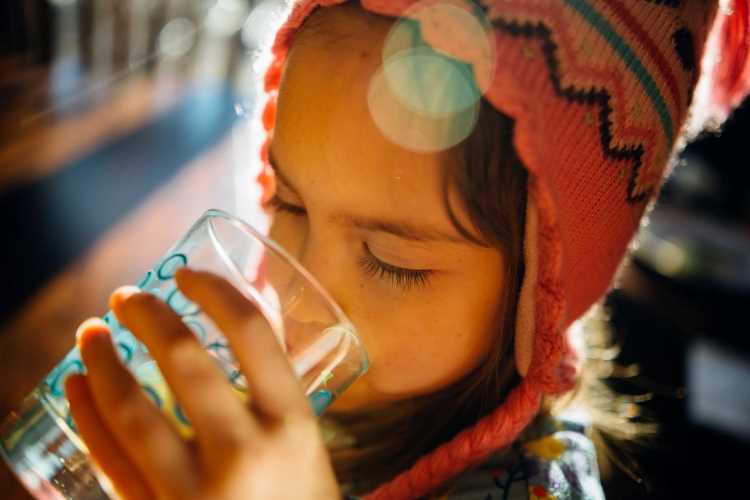
Jal Jeevan Mission was launched by Prime Minister Narendra Modi on August 15, 2019. The mission promises to provide clean drinking water to every Indian household through tap connections by 2024. While announcing the mission, the Prime Minister said that the government has earmarked Rs 3.5 lakh crore for quality drinking water in rural India.
The mission looks to provide fresh tap water to every household in the country, but budget allocations did not match the scope of such an ambitious scheme. Budget 2022 has allocated Rs 60,000 crore for the scheme.
Currently, 45.2% of rural households in India have tap water connections. This means about 55% of India does not have tap water connections and still relies on traditional sources of water for daily use. This highlights the need for Jal Jeevan Mission. In Uttar Pradesh, only 15% of people have access to tap water. In Madhya Pradesh, 35% of people have access while in Rajasthan, only 21% has access to water taps. Bihar has done well among north Indian states with 88% of its population having access to tap water.
READ I Timely action on inflation needed to avert a crisis, says Maurice Obstfeld
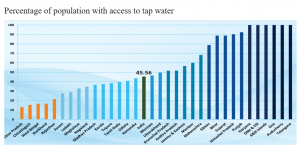
The following comparative data shows the situation before and after the launching of Jal Jeevan Mission.
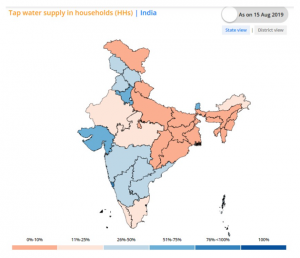
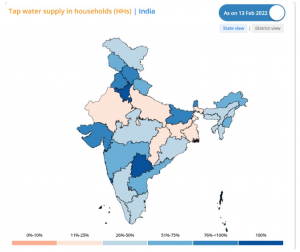
In 2019, only 3.23 crore households in the country had tap water connection, which was just 17% of all households. By October 2021, the number of tap water connections went up to 8.26 crore or 43% of all households. Currently, three states (Goa, Telangana, and Haryana) and two Union territories (Dadra & Nagar Haveli and Daman & Diu) have 100% tap water connection. Telangana achieved 100% coverage in two years of Jal Jeevan Mission from a dismal 29%. For Haryana, the coverage was 57.038% two years ago, and for Goa the figure was 75.7% in 2019. The success of the mission in Telangana is the expression of collective political will of the Union and the state governments.
READ I Universal pension can transform Indian economy
The number of households that need to be provided with tap water connections by 2024 is 7,05,41,360. Before the mission was launched, only 5,16,221 households in Uttar Pradesh had tap water connections (1.953%). In two years, this number has risen to around 30 lakh, but 229.6 lakh households in the state still need tap water connection. Bihar has done an excellent job — in 2019, only 3,16,391 (1.837%) households had connection which increased to 1,54,93,338 (89.91%) in two years.
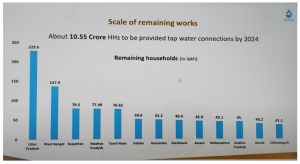
Jal Jeevan Mission is implemented with a bottom-up approach, following the concept of Gandhi’s self-sufficient village republic. The mission results in increased collaboration among various ground-level stakeholders. Each level – village, district, and state – has to adopt a one-time plan for five years termed annual action plan. The plan includes water source strengthening, water supply, greywater treatment and reuse, operation and maintenance, and solid and liquid waste management. The village action plans are to be a part of gram panchayat development plans.
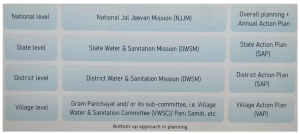
The bottom-up approach is a perfect fit for the Jal Jeevan Mission since India’s geographical conditions are not homogenous. Implementing such a huge scheme with a centralised mechanism would lead to wastage of resources. India’s conditions vary from cold to hot deserts, plains to mountains, alluvial lands to forests, from long coastal belts to many islands. Each region has its own challenges. Additionally, due to uneven rainfall across the country, the amount of surface water each region has is not the same. Considering the situation, the following overall planning is adopted using the bottom-up approach:
- Villages having existing piped water supply systems, remaining households will be given retrofitting so that no one is left out.
- A single village system will be executed in villages having an adequate amount of good-quality surface water.
- Villages with good quantity but poor-quality water will be treated before distribution.
- In isolated tribal or forest areas, standalone solar-based water supply systems will be given priority.
- In water-stressed areas, bulk water transfer treatment plants and distribution systems are to be planned and executed.
Jal Jeevan Mission is being implemented in partnership with states to achieve the objective of providing tap water connection to every household by 2024.
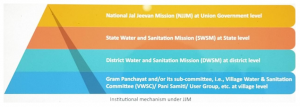
Jal Jeevan Mission: Distribution of responsibilities
Union government
- Implementation of the mission and providing policy guidance, financial assistance, and technical support to states.
- Monitoring funds and supporting states on different components of the mission.
- Overall monitoring on a regular basis and implying corrective measures.
- Carrying out regular impact, functionality, and evaluation assessments.
- Building partnerships with other institutions and programmes.
State governments
- Strategising and planning for best implementation of the scheme.
- Utilising the funds sufficiently and ensuring of funds are not parked.
- Coordinating with different departments and agencies.
- Appraisal and in-principle approval of the state action plan after discussions with the national government
District level
- Finalising district action plan within the purview of state action plan.
- Providing administrative approval to the scheme.
- Engaging implementation support agencies.
Village panchayats
- In-village piped water supply infrastructure and related source development.
- Ensure community involvement in the form of 5% of capital cost in cash/or kind/or labor.
- Collaboration with SHGs, handholding support of Gram Panchayats, Pani Samitis as an implementation support agency (ISA).
Budgetary allocation
The 15th Finance Commission has recommended a Rs 1,42,083 crore tied grant to local rural bodies and panchayats in the next five years (2021-22 to 2025-26). The department of drinking water and sanitation under the ministry of jal shakti will be the nodal agency for determining the eligibility of the rural local bodies for the tied grant for water and sanitation.
State governments are expected to institute a robust operation and maintenance policy to recover charges from households to help them to meet the recurring expenditure on rural water supply and sanitation services for long-term assured delivery. The funding pattern between the Centre and states is 90:10 for Himalayan and north-eastern states, while it will be 50:50 for other states.
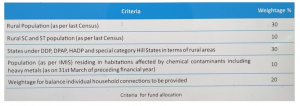
India is half way to achieving the objective of safe drinking water for all (Har Ghar Jal). It has provided 8,98,71,817 households with tap water connection. An additional 7,05,41,360 households need to be provided with connection by 2024. The success of the scheme requires harmonious relations between the Union and state governments as well as community participation.
There are several discrepancies in the government claims. There are pipelines in several villages, but running water still remains a distant dream because there are no water sources nearby. While creating the pipeline infrastructure, the government needs to ensure that the villages get water as promised.
(Shiv Chhatrala is a master’s student at Christ University, Bangalore.)

